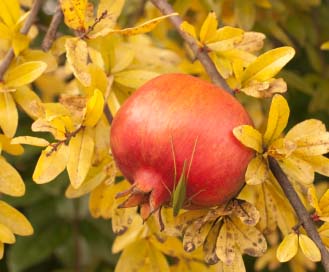In the Garden: the history of fruit trees
Mark Griffiths looks at some unanswered questions about fruit trees


Some years ago, the Oxford botanist Barrie Juniper astonished us by answering the question ‘where do apples come from?' As a result of DNA analysis, remote travels, and investigations geographical, zoological and archaeological, he discovered that our edible crops weren't domesticated crab apples as had long been assumed.
Rather, they were descended from wild and sweet-fruited trees native to the Tian Shan mountain range of Central Asia. Starting millennia ago, they had travelled westwards with human population movements-at first, as seeds in the guts of horses and later as a commodity that we could enjoy, trade and cultivate.
At dinner in Oxford last autumn, I was trying to explain this to the person on my right. I looked for help from Dr Juniper himself, who was sitting opposite me. He obliged and added that he was looking into one more unanswered question about fruit trees, smaller and closer to home, but not without fascination: ‘I've been trying to solve the mystery of the Tradescants' Orchard.'
This is the name given, perhaps as recently as the 1840s, to an album of 17th-century watercolours in the Bodleian Library. Each of its folios pres-ents a different fruit cultivar: one strawberry, one gooseberry, 10 cherries, 23 plums, damsons and bullaces, two apricots, five nectarines, 12 peaches, one apple (only), four pears, two quinces, one hazelnut, and four grapevines.
Originally, there were a few more paintings, but they appear to have gone missing early in the album's life. That should be no surprise. The images are not good, let alone great, botanical art. Even by 17th-century standards, they're naïve and amateurish. But they're utterly enchanting, and evidently the work of someone who loved plants and who loved to paint. Also, and in a way that sometimes only a cartoonist, a child, or a great artist can capture, they do convey the essence of their subjects.
Better still, these fruits are depicted with a cast of friends and foes that includes fly-away ladybirds, psychedelic butterflies, famished frogs, a dyspeptic owl and a nut-blagging squirrel. This charming album has become one of the Bodleian Library's best-known treasures and sweetest windfalls: the paintings have been reproduced on mugs and tea towels by the thousand. And yet, surprisingly little is known about it.
The album arrived in Oxford as part of the legacy of Elias Ashmole, among the objects, books and manuscripts that formed the basis of the Ashmolean Museum. In 1697, five years after his death, the university catalogued it simply as ‘A Book of Fruit Trees with their Fruits, drawn in Colours, about the year 1640'.
Sign up for the Country Life Newsletter
Exquisite houses, the beauty of Nature, and how to get the most from your life, straight to your inbox.
Ashmole had acquired the contents of The Ark, the private museum in Lambeth amassed by the great Stuart gardeners John Tradescant, father and son. Over time, an assumption formed that these paintings once belonged to them, and they became known as The Tradescants' Orchard. Ashmole never gave them that title or provenance; nor did they appear in the Tradescants' own fastidious catalogues.
The notebook-like captions are not in Ashmole's or the Tradescants' handwriting. One seems promising: ‘The Amber plum which I.T. as I take it brought out of France and groweth at Hatfeld: ripe Septem: the. 8.' This does refer to John Tradescant the Elder. He worked at Hatfield from 1610 to 1614 and, in 1611, bought plum trees for its gardens in Paris. But this needn't mean the album was produced by or for the Tradescants. It might equally have been the work of someone acquainted with them and sufficiently horticultural to keep a log of prized fruit-perhaps in his or her own garden.
Who, however, and why and when? In Dr Juniper's book The Tradescants' Orchard, he and Oxford art historian Hanneke Grootenboer tackle these and other questions and propose some intriguing answers. There are also excellent chapters on Ashmole, the Tradescants, and 17th-century horticulture. Above all, there's the entire album beautifully reproduced in facsimile-all 66 plates published for the first time.
‘The Tradescants' Orchard: The Mystery of a Seventeenth-Century Painted Fruit Book' is published this month by The Bodleian Library (www.bodleianbookshop.co.uk) at £30
* Follow Country Life magazine on Twitter
* Subscribe to Country Life and save; Subscribe on Ipad
Country Life is unlike any other magazine: the only glossy weekly on the newsstand and the only magazine that has been guest-edited by HRH The King not once, but twice. It is a celebration of modern rural life and all its diverse joys and pleasures — that was first published in Queen Victoria's Diamond Jubilee year. Our eclectic mixture of witty and informative content — from the most up-to-date property news and commentary and a coveted glimpse inside some of the UK's best houses and gardens, to gardening, the arts and interior design, written by experts in their field — still cannot be found in print or online, anywhere else.
-
 'Monolithic, multi-layered and quite, quite magnificent. This was love at first bite': Tom Parker Bowles on his lifelong love affair with lasagne
'Monolithic, multi-layered and quite, quite magnificent. This was love at first bite': Tom Parker Bowles on his lifelong love affair with lasagneAn upwardly mobile spaghetti Bolognese, lasagne al forno, with oozing béchamel and layered meaty magnificence, is a bona fide comfort classic, declares Tom Parker Bowles.
By Tom Parker Bowles
-
 Country houses, cream teas and Baywatch: Country Life Quiz of the Day, April 24, 2025
Country houses, cream teas and Baywatch: Country Life Quiz of the Day, April 24, 2025Thursday's Quiz of the Day asks exactly how popular Baywatch became.
By Toby Keel